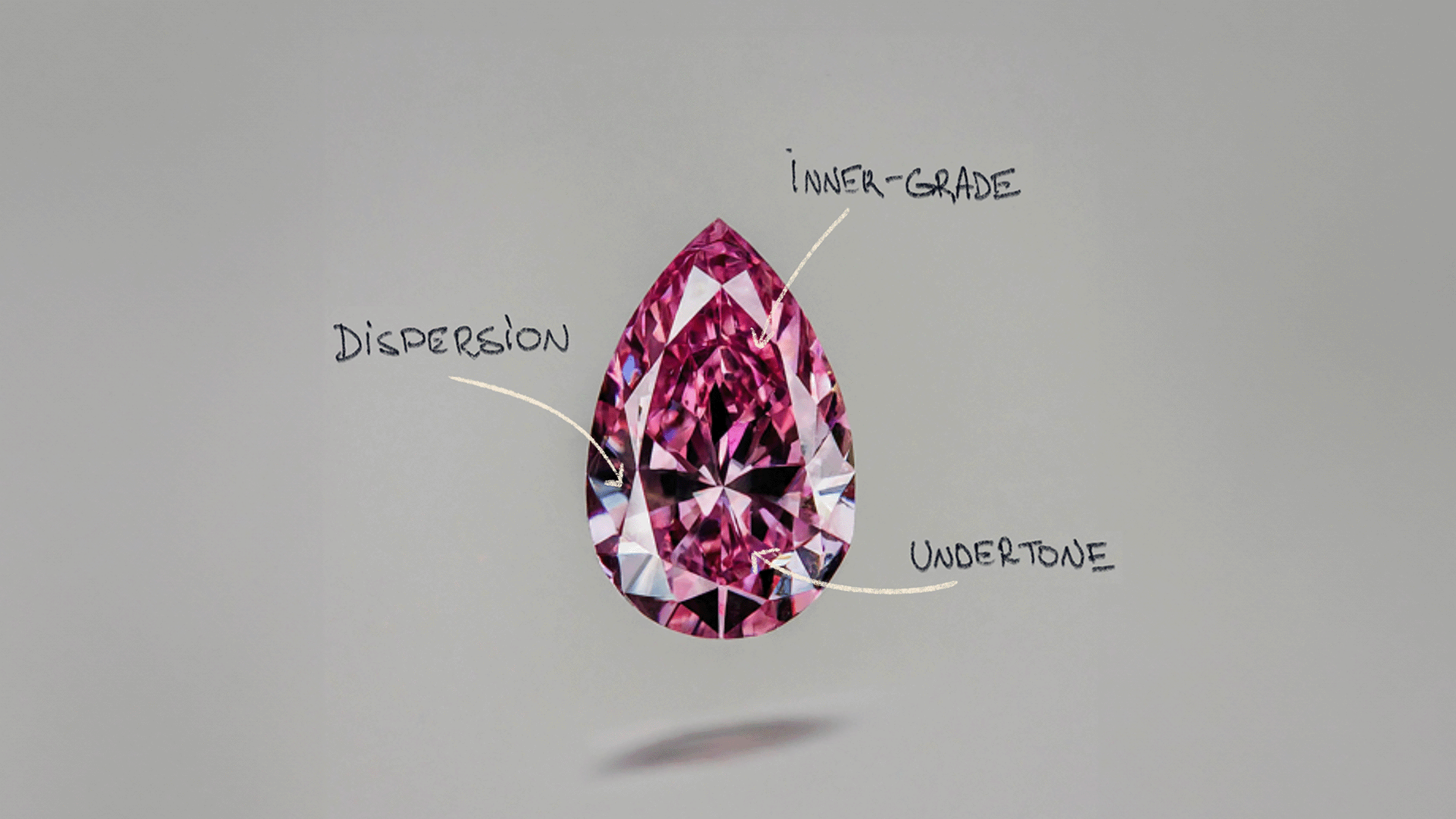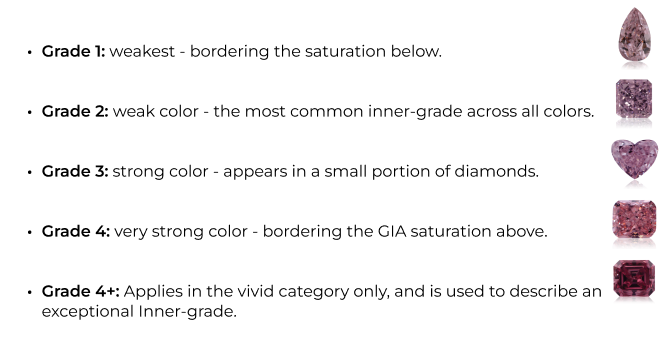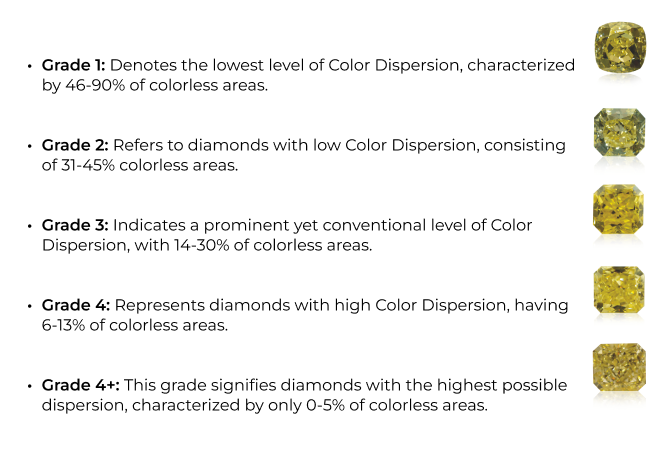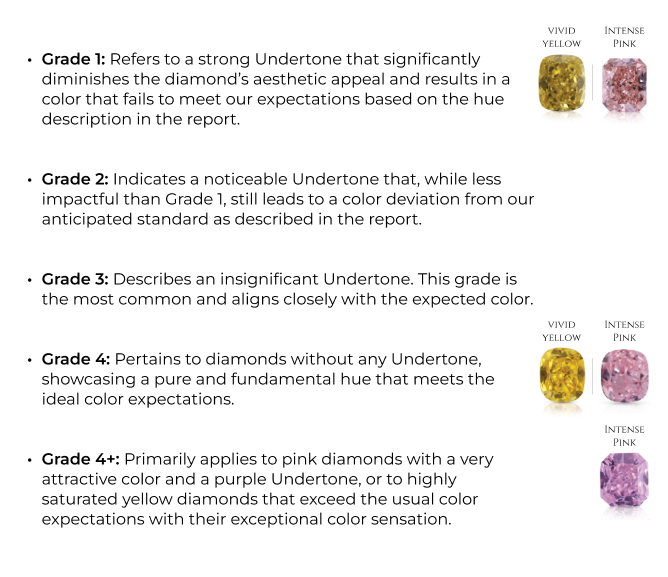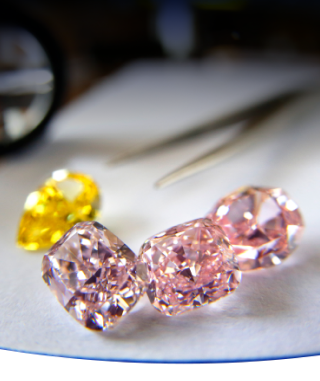Understanding the Value and Aesthetics of Fancy Color Diamonds Through Their Visual Assets
A fancy color diamond is the most precious stone unearthed in the world. Its endless visual appearances make it the most complex gem to evaluate and price in the luxury space. Today, the vast majority of fancy color diamonds are submitted to the GIA lab to obtain a report confirming their natural origin and gemological characteristics. Without this grading, fancy color diamonds cannot be fairly traded. GIA grades on the report relate only to the gemological aspect and do not reflect the visual qualities that make a color diamond attractive and valuable. Consequently, since aesthetic aspects are not addressed during the GIA lab examination, many diamonds sharing the same grades will exhibit numerous visual differences that dramatically impact their market price.
The fancy color diamond market is undergoing significant evolution, driven by a surge in demand from jewelry enthusiasts for these rare gems. This growing interest has seen the rarest of diamonds commanding prices of millions of dollars per carat. In response, manufacturers are vying for rough diamonds, investing meticulous effort to enhance each diamond’s appeal. As part of their strategy to attain higher prices per carat, wholesalers are now more attuned to the visual nuances that are increasingly sought after by consumers. Over time, a broad consensus has emerged around the qualities that enhance a color diamond’s attractiveness and those that might warrant a discount.
Experienced diamond professionals, who have traded a significant number of fancy color diamonds over the years, develop a keen understanding of the three main visual features and their impact on price. Drawing on their familiarity with similar diamonds from a large number of previous transactions, they are able to intuitively appreciate any visual combination and estimate a price for almost any color diamond they encounter.
The vast majority of fancy color diamonds pass through jewelers before reaching the end client. Unlike diamond dealers, jewelry salespeople encounter a limited number of fancy color diamonds during their careers and lack the ability to recognize all the visual nuances that impact their price. Consequently, sales associates gravitate towards the more familiar and conventional terms from the colorless diamond world, such as Polish, Symmetry, Clarity, and Fluorescence, which do not address the aesthetic aspects of a fancy color diamond in any way. This leaves jewelers unable to explain the price differences between any two diamonds with the same report.
Historically, the diamond and jewelry industry lacked mechanisms for transferring practical knowledge from wholesalers to jewelers, leaving key visual qualities that influence fancy color diamond value unexplained. Recognizing this gap, the Fancy Color Research Foundation initiated in recent years a broad effort to standardize visual grades, akin to how the GIA has shared knowledge on colorless diamonds.
In 2012, the IDU grading methodology was introduced in professional literature and quickly gained traction among jewelry brands and independent jewelers. Following this widespread adoption, the FCRF secured the rights to this methodology, aiming to establish a common language that enhances engagement between jewelers and their collectors.
Utilizing the IDU Grade Scores
In this section, we will detail the visual criteria—Inner–Grade, Dispersion, and Undertone, collectively known as the IDU. These criteria describe three crucial visual elements that, when analyzed correctly, can assess a natural color diamond’s quality and reliably convey the information of its visual appearance from wholesalers to retailers and their private clients. Adding up the numerical grades 1 through 4+ provides a reliable indication of a diamond’s aesthetic appeal and value. Every color diamond is unique and possesses inherent rarity, irrespective of its IDU grade. Nonetheless, color diamonds receiving a total grade of 9 or higher are generally considered to be easily traded and in higher demand, particularly when long-term wealth preservation is considered. An exception to this rule would be diamonds that, despite achieving a total grade of 9 or higher, score low in Undertone and Dispersion. Conventional features such as low clarity, strong blue fluorescence, and poor proportions or small face-up can also impact the quality of a diamond with a high IDU score.
An additional point is the introduction of the “True Face-up” calibration grade, an aspect external to the IDU. This grade indicates whether the carat weight of a fancy color diamond is fully expressed through its face-up surface. Until recently, measuring and implementing this feature effectively was not possible. However, the FCRF has now developed a tool that offers a solid indication of this crucial characteristic.
The Inner-Grade
The GIA saturation grades for fancy color diamonds (i.e., fancy, intense, vivid) span over a range across 3 to 5 different inner-grades, depending on the GIA saturation grade. The Inner-Grade refers to the strength or richness of each level within the range.
Color Dispersion
Color Dispersion refers to the extent of color spread across the face-up view of a diamond, with the dispersion grade ranging from very low visible color to complete color coverage. This visual characteristic heavily relies on the cutter’s skill in strategically arranging the diamond’s facets to maximize the color mosaic on the face-up view.
Round brilliant, old-mine, and step-cut diamonds are exceptions to this practice. In these shapes, creating a color mosaic is not feasible as it would deviate from their recognized cuts. Therefore, in round brilliant and step-cut diamonds, Color Dispersion is assessed within the constraints of traditional facet alignment, making the dispersion standards more forgiving compared to all other shapes.
Undertone
Undertone refers to a visible color sensation that is not defined as a color modifier on the report. The Undertone plays a crucial role in determining whether the color we perceive matches our expectations based on the GIA color description.
Colors known by their hue names (e.g., blue, yellow, red, green, orange, purple, pink, etc.) are ingrained in our subconscious in their most fundamental forms, as they were initially introduced to us in our childhood. A noticeable Undertone that deviates from the diamond’s fundamental color form can make a fancy color diamond less desirable. Conversely, an Undertone that produces a pleasant sensation can enhance the diamond’s beauty.
Below are two clear examples of Vivid Yellow and Intense Pink, at the top, both stones within Inner-grade 1, exhibiting a warm Undertone that reduces their aesthetic appeal. Grade 4 represents the yellow and pink in their ideal form, while Grade 4+ features a purplish pink diamond with a cooler sensation that commands a significant premium. A purple modifier doesn’t always give a pleasant sensation; in some cases, it can also generate an unpleasant gray sensation, resulting in a low undertone grade.
Some more undertone examples:
- The presence of a bright orange Undertone in a yellow diamond does not detract from the way most of us perceive the color yellow. This Undertone evokes sensations associated with positive imagery, such as sunrises or fruit. On the other hand, a brown or green Undertone can distance a yellow diamond from its fundamental hue, potentially leading to a discount.
- Pink, a lighter shade of red, exhibits a wide range of Undertones. When a pink hue leans towards the cooler part of the color spectrum, i.e., towards purple, it meets our expectations for this color definition and often commands a premium as it is associated with positive qualities considered innocent, feminine, or with sweets. As the industry lacked Undertone standardization in past years, a few nicknames such as ‘baby-pink,’ ‘sweet-pink,’ and ‘bubblegum-pink, have filled the gap to describe these color variations for pink diamonds. This is why most pink diamonds with a purple color modifier are more attractive than most single pink color diamonds. When the Undertone leans towards a warmer hue, such as orange or brown, the market tendency is to slightly discount these pink fancy Color diamonds as they don’t meet the client’s expectations for a pink diamond.
- The Phosphorescent Undertone in green-yellow or yellow-green diamonds results in a brighter color sensation and as a result creates a wide range of associations that are reflected in those nick-names invented intuitively by the industry, such as: “Apple green”, “Radio-active green”, “Electric green”. Those who don’t exhibit this internal yellow or green luminescence may appear with a muted color and are considered less attractive.
- In blue fancy color diamonds, we encounter two Undertones: Gray and Green. The gray Undertone is the most abundant and appears in most blue diamonds. A large amount of gray in the hue distances the color from its fundamental blue, creating a steely color sensation and often resulting in a discount. Blue diamonds with no Undertone are known by their nicknames, such as Sky-blue, Ink-blue, and so on. The green Undertone in blue diamonds is rare and usually indicates that the diamond is not type IIb. While this Undertone might result in a discount, it’s not due to an aesthetic flaw but because it falls short of meeting the expected color grade indicated on the report.
The True Face-Up of Carat Weight – External to The IDU
Fancy color diamonds with high color dispersion are often cut in a way that maximizes light reflection. This technique not only enhances their dispersion from a face-up view but also allows for a greater weight within a smaller outline. As a result, many of these diamonds appear smaller compared to colorless diamonds, and even when compared to the average fancy color diamond. In terms of valuation, diamonds that are slightly smaller than average are met with some tolerance, whereas those appearing significantly smaller may see lower demand and may need to be discounted. Conversely, diamonds with a large face-up view relative to their carat weight receive a premium.
Currently, the depth percentage is the only metric professionals use to evaluate a fancy color diamond’s proportions. However, after cross-referencing measurements of about 40,000 fancy color diamonds with their respective weights, we discovered numerous instances where no correlation existed between their depth percentages and average surface area. This led us to conclude that the depth figure is not an adequate indicator for fancy color diamonds. Instead, calculating the average surface area for each weight group provides a reliable metric that accurately reflects whether the price per carat of a diamond truly represents its average appearance. The FCRF Diary Report includes the True Face-Up tool, offering buyers a clear assessment of this crucial visual element.
Here are two output results for example, one commanding a premium and one a discount:
In conclusion, the importance of standardizing the visual appearance of fancy color diamonds extends beyond mere aesthetics; it is essential for effective communication within the industry and crucial for enabling retailers to articulate the subtleties that influence pricing to their clients. Establishing a common language for the visual attributes, including the critical aspect of face-up appearance, is fundamental. This standardization ensures that all parties—from wholesalers to sales associates—can accurately understand and convey the reasons behind price variances, especially when considering the face-up view that significantly affects a diamond’s price per carat. By doing so, the industry can offer greater transparency and foster trust with consumers, enhancing their purchasing experience by providing deeper insights into the unique qualities of each fancy Color diamond.
A standardized approach to grading the visual appearance empowers the industry to better meet consumer expectations and celebrate the distinct beauty of each fancy color diamond, ensuring their value and splendor are recognized and appreciated at every level.
